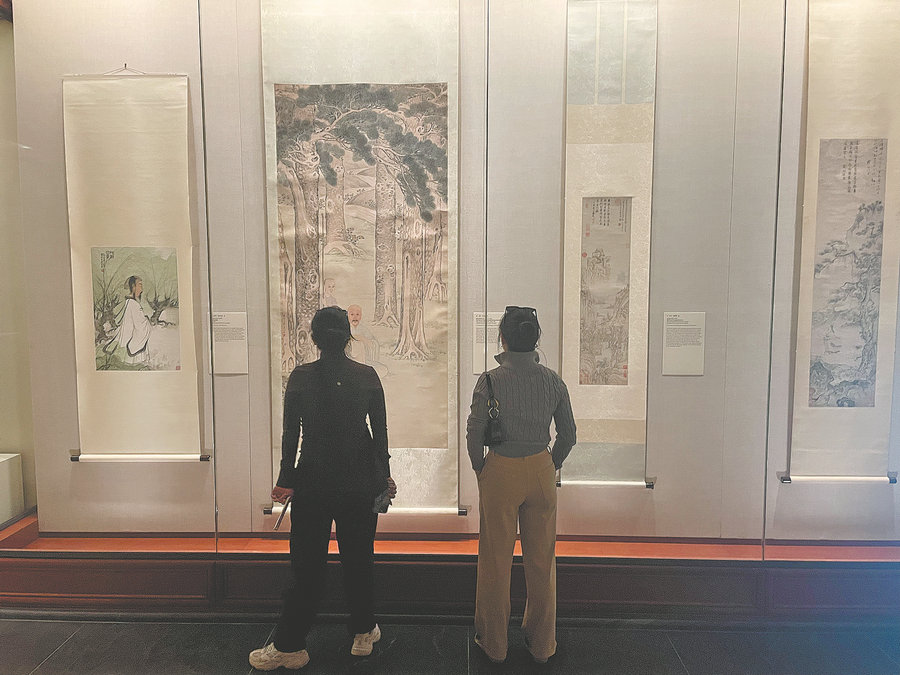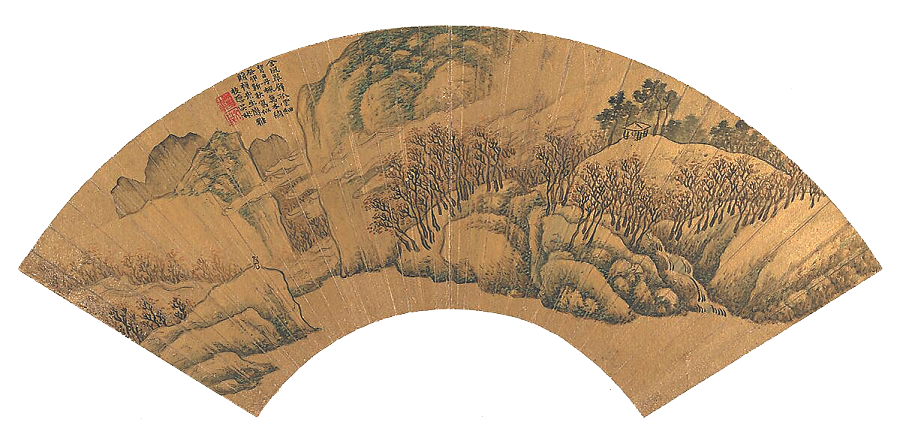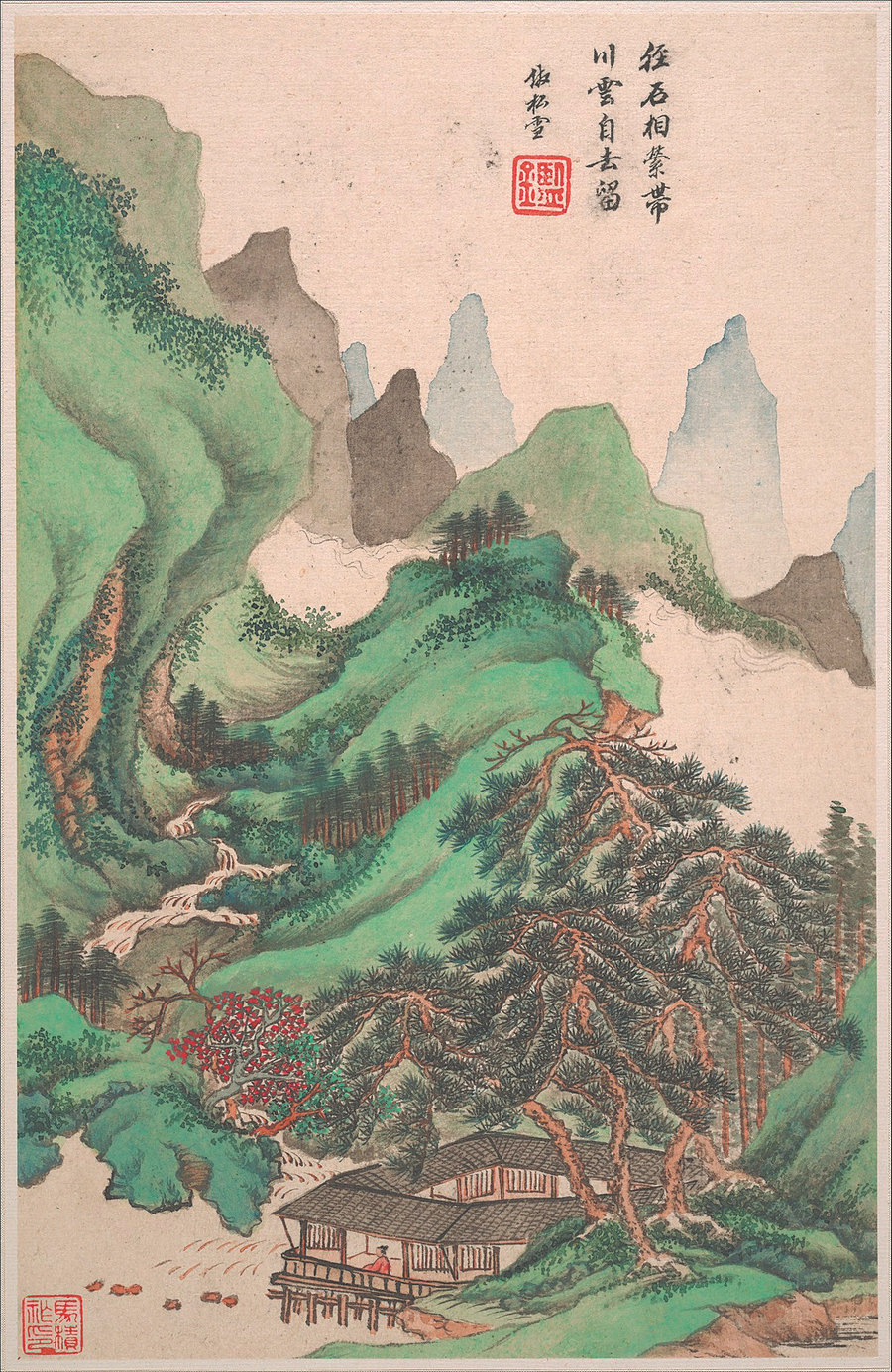
Exhibition Expounds on "Vision and Verse" in Chinese Art
This landscape painting of an album by Wang Jian was made in response to a line of poetry by Du Fu. [Photo provided to China Daily]
"As there happened to be a volume of Du Fu's poetry on the table, I selected one suitable couplet for inscription on each of my landscapes," wrote Wang Jian, a much celebrated painter living in 17th-century China, on the final page of an album of pictures he painted for a longtime friend.
Wang also wrote that he had genuinely enjoyed the friendship since the days "when we were young and vigorous".
For Joseph Dolberg, an expert on ancient Chinese painting from New York's Metropolitan Museum of Art, the painted album, with each page in the style of an old master who had come before Wang, is a priceless item of art.
It is also a testament to the friendship between two deeply cultured men who shared not only a passion for art, but also pain and suffering.
Moreover, it provides a partial understanding of a phenomenon in Chinese art history.
"When painters sat down to paint in ancient China, why were they so often painting poetic themes?" asked Dolberg, who has attempted to answer that question through an exhibition titled Vision and Verse: The Poetry of Chinese Painting. The exhibition is on at The Met Fifth Avenue galleries in New York and features 90 works drawn almost entirely from The Met's collection.
Although Wang made his choice of poems sound purely accidental, in reality this may not be the case, said Dolberg.
"Based on my unscientific observation of Chinese painting history, Du Fu (712-770) is the most often inscribed poet from the Tang Dynasty (618-907)," he said, referring to an era in Chinese history when poetry writing is believed to have reached an artistic pinnacle.
Around 1,150 poems attributed to Du that have survived to this day offer proof to the immensity of his oeuvre, which a latter-day painter could "go to and grab whatever he wanted… to deepen and expand his viewer's pictorial experience and imagination", to quote Dolberg.
But that number alone can't explain it all. "The prestige of Du Fu the poet started to grow posthumously, during the final century of the Tang Dynasty," said Zhang Yinan from the National Library of China who specializes in ancient Chinese poetry.
"It reached such a height in the succeeding Song Dynasty (960-1279) that Du Fu became a cult in himself, commonly worshipped by educated members of society, some of whom, Su Shi included, had used brushes to write and paint," said Zhang, referring to the Song Dynasty polymath who was in turn immortalized by his own words.
This was despite — some might say because of — the fact that for a large part of his life, Du had endured, if not outright anonymity, then repeated rejection and constant poverty. "Du's personal travails had certainly struck a strong chord with those who were subjected to similar experiences at one point or another, and who constituted the bulk of the literati group in pre-modern China," Zhang said.
In another painting on view at the museum, a speck of a figure stands atop a low cliff facing the magnitude of nature. The painter, from the 17th century, adorned his fanned-out work with two lines from a Du poem that goes: "The emerald cliff catches the breeze, a lone cloud thin; Red maples, their backs to the sun, ten thousand trees dense."

Visitors appreciate the artworks of the exhibition Vision and Verse: The Poetry of Chinese Paintingat the Met Fifth Avenue galleries in New York. [Photo provided to China Daily]
Familiar solitude
For Dolberg, the sense of solitude permeating the painting is all too familiar. Within the same gallery, a not-so-distant echo is sent by another painting, done during the 12th century, which depicts a man hurrying through a bare-branched winter forest on the back of a donkey. A boy attendant runs head of him, suggesting that the protagonist was a scholar, albeit a slightly woeful one who, seeking warmth, has clasped his hands inside the opposite sleeves. It seems that his broad-rimmed hat is hardly a shield against the chilly blast, as his boy companion offers little consolation.
The painting doesn't identify the man, but Dolberg believes he is Du's contemporary Meng Haoran (689-740) who, by the time of the Song Dynasty, had already come to embody what the curator calls "the visual iconography of the donkey rider", providing Chinese art history with the image of a suffering poet-intellectual.
"These days we see paintings of travelers in forests, and scholars sitting by waterfalls that don't have a specific title. Yet we have to be aware of the fact that a painter from the 12th century was painting for a very different audience than the one coming into The Met Museum in 2024," said Dolberg. "Those were people who were constantly reading and writing poems. And to speak to that level of scholarship, a painting, rather than being generic, was more likely to have depicted a famous poet or poem that was very much on the minds of people in pre-modern China."
In talking about "scholars sitting by waterfalls", the curator was thinking about one man — Li Bai, Du's hedonistic friend who famously wrote, probably after some good drinking, "A cascade plunges a sheer three thousand feet, as if the Milky Way is tumbling down from the sky."
Both Du and Li had once been associated with the image of a donkey rider. But Meng clinched the deal partly thanks to his poet-painter friend Wang Wei (693-761), "one of the first famous Chinese poets who also painted", to use the words of Dolberg.
For any student of Chinese art history, Wang Wei's far-reaching influence on Chinese art is best summed up in his own words — "Poetry and painting share the same source."
"What Wang Wei was trying to express is very similar to the idea embedded in the ancient Latin phrase 'Ut pictura poesis', meaning'as is painting, so is poetry'," said Dolberg. "It appears to me that in both China and the Classical Mediterranean World and Europe, intellectuals and artists had been thinking deeply about the close relationship between these companion arts for some 2,000 years."
For more than a millennium, legend had been growing around poems and paintings Wang Wei had created depicting his country estate in modern-day Lantian county, Shaanxi province. While the poems have survived, the paintings — like all other ones traceable to Wang Wei — today exist only in copies including rubbings by later artists.
Drenched in the master's signature bucolic idealism, the poems have collectively spawned, throughout history, the biggest number of painterly reinterpretations, one of which Dolberg has included in the current exhibition.
In another work on view, the 14th-century painter Tang Di wrote in his inscription that his painting was inspired by a Wang Wei poem, but stopped short of specifying which one. "Tang was likely to have played a game with his knowing audience," said the curator, who himself willingly took up the challenge.
"'I walk to the place where the water ends; and sit and watch the time when clouds rise'. Those are the lines from Wang Wei that I believe Tang had in mind," said Dolberg, who described the painting as having been executed in the "strength and grandeur of the northern school (of Chinese painting)" while capturing the "light meditative mood" of Wang Wei, the reputed founder of the southern school.

Wangchuan Villa, by an unidentified artist, is on exhibition at The Met Fifth Avenue galleries in New York. It depicts China's eighth-century poet and painter Wang Wei's country estate in Lantian county, Shaanxi province. [Photo provided to China Daily]
Utmost respect
Then there's the friendship between Wang Wei and Meng Haoran.
"Stay inebriated with rustic wine, read ancient books in mirth," was the poetic advice from Wang to a disillusioned Meng who, having failed to find fame and a position in the Tang Dynasty capital, was heading back home for a sequestered life.
Judging by all evidence, Wang had always treated his friend with the utmost respect. "As graceful as Meng Haoran was in a Wang Wei painting", was how a renowned Song-dynasty calligrapher described a painting by early-Song artist Li Cheng (919-967) that shows a scholar and his boy attendant traveling in a wintry forest.
The one on view at the Met Museum, once attributed to Li Cheng, is believed to be a 12th-century copy of the original painting.
Mining the legacy of the Tang Dynasty, the greatest era of Chinese poetry, the Song painters produced misty landscapes that "matched the dreamy quality of the poems", to quote Dolberg. In other cases, even paintings that were not explicitly based on poems could sometimes evoke famous verses in the minds of their viewers.
"It was really during the Song Dynasty that Wang Wei's idea of painting and poetry sharing the same source had started to blossom," said Dolberg, who believes that the delay was due to a strong tendency among the educated elite to view poetry writing as a much nobler pursuit than painting.
One man who certainly did not think that way was Su Shi (1037-1101), the Song-dynasty polymath who was equally celebrated for his poetry and prose, painting and calligraphy.
"A picture resides is every piece of (his) poetry and vice versa" is Su's accolade for Wang Wei, an idea he "not only upheld but also revolutionized", to quote Dolberg.
"He did that by going back to how simple and beautiful the idea is. Through poetry, you can express what's in your heart; through painting, you can do it too," said the curator.
Two of the master's paintings arguably exist today, and both depict simple subjects as a grotesquely-shaped stone and tree. "They are more evocative than descriptive — a poem instead of a long essay," said Dolberg.

Azure Cliff with Red Maplesby Ming Dynasty painter Wu Bin. This scene of human encounter with nature is accompanied by a verse by Tang-Dynasty poet Du Fu inscribed by the painter. [Photo by Su Qiang/China Daily]
Literati painting
Self-expression, filtered through literary sensibilities, was at the heart of a unique Chinese art phenomenon known as "the literati painting", of which Zhao Mengfu (1254-1322) was a powerful exponent.
Zhao came up with the idea that "calligraphy and painting share the same source", which may sound to some like Wang Wei's take on the relationship between poetry and painting. "It's more like an homage that represented another key development in the creation and acceptance of the concept of literati painting," said Dolberg.
"Zhao probably had started reading poetry since (the age of) three. And the idea that he wasn't aware of most of Wang Wei's writings is just not credible," he continued.
"So he was trying to add to Wang's idea by saying that painting can't just be painting — it has to be like poetry, it has to be like calligraphy, otherwise it's not suited to a gentleman who's a member of the literati."
And for a painting to live up to that standard, it naturally had to include poetry and calligraphy which, together with painting itself, made up for the so-called "three perfections" required of a literati painter.
"The idea of a painter writing his own poem rendered in his own calligraphy to create this kind of total artwork had fundamentally changed the landscape of Chinese art for the next 600 years," said the curator. "That's why we need to take a deep look into the poetry of Chinese painting, not just as a way to gauge feelings and emotions, but also as a resource for understanding what it means to be part of the Chinese culture."
That being said, the feelings and emotions, even concealed in allegorical images or a landscape inspired by a nature vignette composed by Wang Wei or Du Fu, had never failed to resonate with a listening heart.
"When we were young and vigorous, we flew about in high spirits …In our old age, both of us have suffered disappointments: once again we were alike," wrote Wang Jian of himself and his friend, for whom his album of Du Fu poetry-inspired landscape paintings was intended.
"I leave this album with him so that even while reclining, he may still go wandering."
